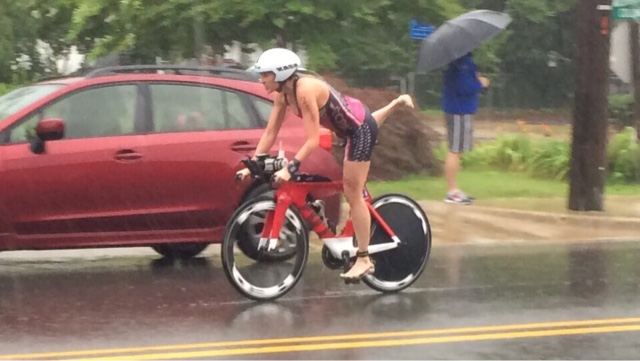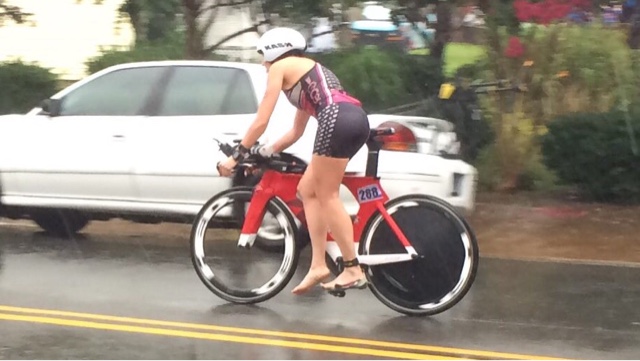I generally waste zero time in transitions and typically place high in transitions. I leave my shoes on my bike. I used to dazzle my cul de sac neighbors (haha) practicing this skill before races. I also still clip into my pedals like its my first day in the sport and fumble a lot so I tend to just leave my shoes on my bike for T1 and T2. It’s easier for me and faster as well.
These dismounts are very fun and easy to learn so I’m going to share the joy for those who don’t already do this. Nick took some great shots of this trick at the Colonial Sprint Tri last weekend. If you’re a female 35-39 (my new Age Group) I recommend that you disregard this post. : ) You ladies should spend as much time as possible in transition. Primp a little so you’ll look good in the finish pictures. Transition for the 35-39 F group is a great time to order a pizza or catch up on your summer reading and maybe relax and take a nap before running. I’ll go on ahead. ; ) Haha.
Otherwise, for all other age groups here is how to complete these fast and fun flying dismounts:
1. Always make sure you know exactly where the dismount line is so you have enough time to slow. Step one is locating the dismount area (perhaps as you sip coffee and/or osmo) before the race starts. Look for any potential hazards to be aware of such as cracks in the road or landmarks. Yes, my risk mngt skills are coming out here but you don’t want the road to take you down! Staying vertical is much faster. Once the area has been assessed go race and don’t worry about the dismount until it’s time.
2. Heading closer to the finish line, slip your feet out of your shoes one at a time while in motion and then continue to pedal with your feet on top of the shoes. I undo the Velcro on my shoe and then hold the heel while my foot comes out. The other hand hold the bar and my head continues looking at the road ahead. Do not look down at your feet as you do this. You go where your eyes go. Down isn’t where you want to be! Before doing this, also be aware of the road surface, your surroundings and other riders to ensure it’s safe and you have enough space. Again, staying vertical is faster than falling over from a crash from distractions. Also, be careful when placing your feet on top of your pedals. Be sure that your feet land firmly on top of the pedal over the shoe. Sideways motions or pushing down on the toe can flip or kick the pedal off the cleat. It’s not likely but I’ve seen it happen. Losing a shoe can cost time or even result in an “abandonment’ penalty if you lost the shoe and can’t find it depending on the race. Also, shoes are expensive and feet are delicate. Don’t hurt your feet.
3. Brake to slow down until you’re at an easy coast with the dismount area in sight. Once speed is safely reduced and you’re just rolling slightly, grap the base bar with both hands and stand up on your pedals. Be aware of other cyclists and the terrain. Know where the line is. Crossing the dismount line while on your bike can result in a disqualification so make sure you’re judging the speed and distance to the line. Now is not the time to look down at your toes and admire the race day pedicure or fumble with your watch or gadgets.
4. Shift your body weight to your left foot and your hands. You’ll feel balanced in the position for a second. Then, lift the right leg up and back. If you have a rear water bottle cage make sue that leg is high. Bring the right leg around the back of the bike. I do this with a bent knee and my foot nice and high.
5. You’re continuing to roll forward as the leg swings around the back of the bike simply slip it between your bike and your left leg. Don’t let go of the bars. Remain stable and balanced on your standing leg.
6. Continue to slide the right leg in front of the standing leg. You’ll step off with this foot.
7. Step down with that right foot and then step the left foot off the pedal. (update: My friend/knowledgeable tri mentor, Coach Kurt indicates that he would put the “flying” foot behind the leg rather than stepping through. He says this is what they do in cyclocross. This flavor is not pictured).
8. Maintain control of yourself and your bike and beware of surroundings and other athletes at all times as you move towards the dismount line. Once both feet are on the ground switch how you hold the bike to how you typical run/travel with it. I grab my saddle typically, but do what works best for you and gives you the most control and confidence with your bike.
9. Run across the dismount line! Go finish the race nice and strong!
I recommend practicing this in advance and refresh the day before until it is a second nature skill. Do not attempt this tricky move in a race until you can perform this straight through from shoe removal to dismounting in time to run across a designated line at least 15 times in a row without any issues. When you are racing it’s harder to think due to the physical and mental demands of the day so the moves need to be ingrained before taking the risk. Conditions on this day were not ideal. If it’s raining exercise extreme caution or skip it. Vertical is always faster than botching a fancy trick in transition in front of your Sherpas during the one time they may see you mid race in the long day nonetheless.
Also, you do want to use the correct feet. Stand with the left. Swing with the right. You want to run through the line and back to your prank spot with the bike on the correct side of your body as the opposite way would have the chainrings next to you which just isn’t cool.
Enjoy!







